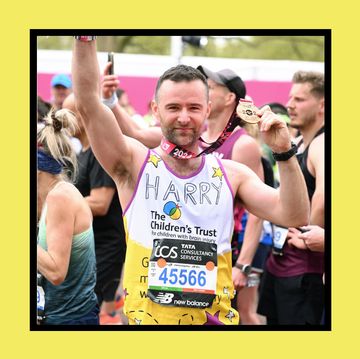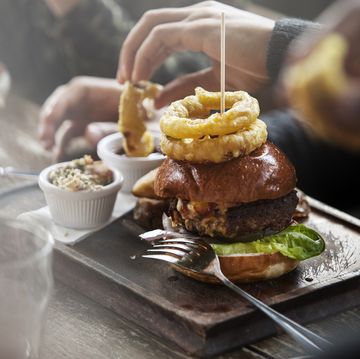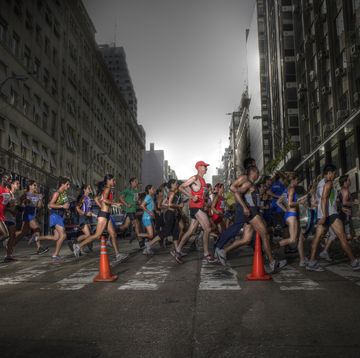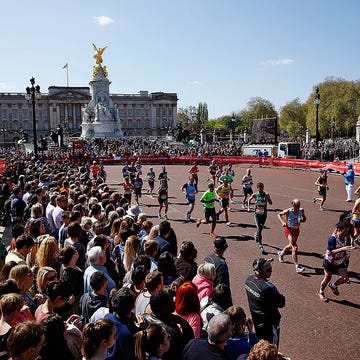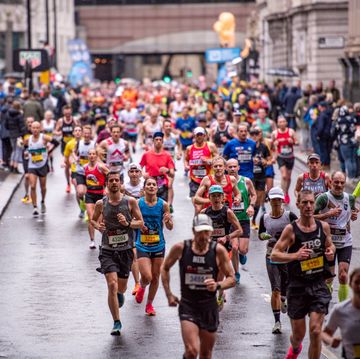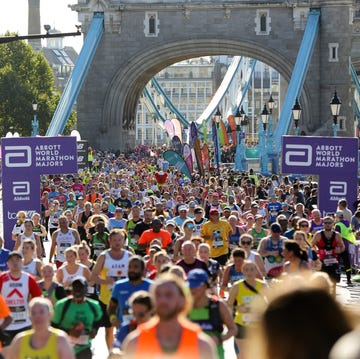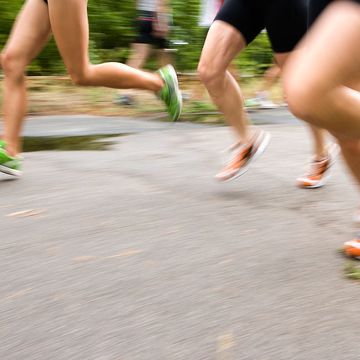Watching people complete their first marathon is truly inspirational. This year, the London Marathon had such an impact on viewers that it received more than 840,000 applications for the 2025 race, smashing the previous record of 578,000 set by last year's ballot.
If you've entered or are thinking about signing up to your first marathon, you may, understandably, be feeling a mixture of excitement and fear. But, with the right training and preparation, your debut 26.2-mile race should be an almighty success – and something that you'll even enjoy. After all the race is a celebration of all your hard work in training.
'Approach the race with joy and gratitude, not as a life-or-death thing,' says Molly Seidel, an Olympic marathon medallist. 'A lot of people are overly serious, but you can be focused and still have fun with it.'
So, breathe deeply and read on for our best tips, tricks and expert advice to guide you all the way to that marathon finishing line.
Have a clear goal
From the outset, you need to know what your intention is. Do you want to simply complete a marathon in any given time or are you looking to break a certain barrier such as sub five, four or three hours? The next step is to understand whether that goal is realistic. The last thing you want to do is set yourself up to fail by placing the bar too high, says running coach and 50k World Champion Carla Molinaro.
Running a 5k or 10k time trial (basically run the distance as fast as you can) and inputting the information into a pacing calculator is an accurate way to estimate your marathon time. This will then allow you to set appropriate training paces and get a sense of what marathon pace feels like.
Give yourself 20 weeks to train
Beginners should start training long before the race, says Andrew Kastor, coach of the Asics Mammoth Track Club in Mammoth Lakes, California. A four-and-half-month training cycle builds up your endurance and aerobic capacity – the secret sauce in a marathon.
'A lot of people could go out there and drag themselves through a 5K, but it’s much harder to do a marathon if you haven’t put in the work,’ says Rob Watson, ex-pro marathoner and head coach for Mile2Marathon in Vancouver. ‘The more time you give yourself to do it, the more prepared you will be on race day. You don’t want to cram for a marathon.’
But iIf you can already run non-stop for 90-minutes then a 12 week training schedule will be effective, says Molinaro.
'If you're starting completely from scratch then you probably want 20 weeks to train because it needs to build up. So it kind of depends where you're where you're at,' she adds.
Get comfortable running at least 18 miles
Long runs accomplish two things, says Kastor. ‘Number one: they develop confidence. And number two: they train your body to recognise what it’s like to run on fatigued legs – because when you get about 20 miles into a marathon, your legs are like stubs.’
Slowly build up to 18 to 20 miles for two long runs, Kastor says.
'You don't need to do the full distance but you do need to have some of those longer runs in there. If you're aiming for a three hour marathon your longest run is probably going to be two and a half hours. If you're going for a four hour then your longest run will probably be three hours. You don't need to go much further than that. Especially if you're just starting,' adds Molinaro.
After you hit at least 18, step down to about 13 miles for three weeks, Kastor says. Then go back up for one more 18-miler to close out the training cycle.
Find a support system
Finding the motivation to go out and run when the weather is miserable or you're just not feeling it, is rally hard. But running with others or being part of a running club does wonders for accountability and mental resilience.
'Finding a group to train with is a game changer. They're going through it with you, and they make it way more fun. Even if, when you're doing the actual session at the time, it's horrible, and it's hard and you're not really talking, you're gonna have a coffee and a piece of cake afterwards, and you can share that accomplishment with someone else,' says Molinaro.
Ask your local running shop or search social media for clubs and groups to help you find the right crew. Working with others can also give you accountability, structure and confidence and if they have run marathons before their expert advice and experience will be invaluable.
Take two days a week off from running
It is possible to train for a marathon on as little as three runs a week, so don't feel pressured to run everyday. In fact doing this will be counter-productive.
‘You need to allow your body time to adapt,’ says Watson. A day without running may not feel productive, but your body is recuperating from any minor muscle tears or tissue damage that’s occurred during your training and getting used to the strength you’ve built up. Plus, it allows your mind to reset and will keep your motivation high. It all adds up to a faster race time.
New marathoners should dedicate one day every week to a cross-training activity such as cycling, swimming or yoga, Kastor says, and also take at least a day completely off each week. On these rest days, foam-roll, stretch, eat well, sleep and let your mind and body heal from the stress of marathon training. It's also vital to strength train to prevent injury and protect your body from the extra load you are putting it through. Incorporate one to three strength and conditioning sessions into your weekly routine.
Getting plenty of sleep, is a big must, as this is where your body will get the gains from all the training, says Molinaro. 'If you've done a really big hard run, and you feel absolutely exhausted the next day, but you've got a run on your programme, you're probably going to be better off having an extra day's rest, then going out. Listen to your body and be flexible with your plan,' she advises.
Add marathon pace to some long runs
Race-day success, Kastor says, ‘comes down to the long runs, training and getting used to the pace.’ As your body gets more familiar with race pace, it also becomes more efficient at it. It will also get used to running the pace on tired legs.
Molinaro recommends building up to a 4x 5k marathon pace session, with a 1k recovery run in between each repetition. 'Don't just jump to that straightaway. Start off doing two by 2k at marathon pace and then the next week, four by three, four by four building up to four by five,' she says.
Another option for an 18- to 20-miler with marathon pace is a progressive long run. Take the first couple of miles easy, miles two to seven at 15 seconds per mile slower than goal marathon pace, miles eight to 13 at goal pace and the remaining miles at 10 seconds per mile faster than goal race pace. This run is best implemented in the final eight weeks of your training plan.
Don't stress about completing a 20-mile long run
During their training cycles, many coaches – including most featured here – tell their athletes to hit 20 miles at least once. ‘There’s a big psychological benefit on race day to completing the 20-mile training run,’ says Kastor. It’s a major confidence booster, Watson agrees. But is 20 really a magic number?
‘It’s just a round number,’ says Kevin Hanson, coach and co-author of Hansons Marathon Method. The book and method have guided thousands of amateur runners to marathon finish lines with training plans that never ask for more than a 16-mile long run.
‘The biggest drawback to our plan is convincing people that 20 is just a number,’ he says. The Hansons Method prioritises consistent work over the course of a week to build your overall mileage, rather than emphasising one extra-long run in a week.
A 20-mile run is overkill for many new marathoners. For runners averaging 10-minute miles, a 20-miler will take almost three and a half hours. ‘Running over three hours for a training run has been shown to have a point of diminishing returns,’ says Roberta Groner, a coach for Central Park TrackClub in New York and a pro marathoner.
Hanson has his athletes practise their marathon pace over and over again, ‘on days when you’re tired and on days when you’re hungrier than you should be at the start’. This way, you get used to running on sore legs as well as holding back when fresh.‘Often, training plans have you take the day off before a 20-miler, which is like a mini taper,’ Hanson says. Instead, he wants your long run to feel like a simulation of the end of the race, when your legs are feeling the fatigue.
So should we all forsake the 20-miler? Not if you enjoy that style of training plan or it works better for your schedule. Plans featuring a handful of long runs in the region of 20 miles are more feasible for the runner who amps up their training on the weekends, Kastor says.
Or if you’re the type of runner who wants to spread their training evenly across the weeks– like Groner, who found the Hansons Method was better for her as she was raising young kids – then dive into that approach.
Start refuelling as early as 20 minutes into your race
Fuelling your marathon correctly is key to avoid hitting the marathon wall. This is when your legs can barely move, you feel like you’re crawling and you're battling your mind over your body. Also known as ‘bonking’, it even happens to pros, like Keira D’Amato, former US record holder in the marathon, who hit the wall hard at around mile 20 of her first marathon in 2013 and had to walk most of her last six miles.
You hit the wall when your body runs out of glycogen, which is energy stored in your muscles and liver, says Dr Alison Helms, a certified personal trainer and creator of the Women’s Running Academy. Our bodies store about 2,200 calories in glycogen, which will fuel us for somewhere around 18 to 20 miles. Once your body’s main fuel source is gone, your brain ‘wants you to stop and turns on all the signals’, Dr Helms says. You may cramp up, feel fatigued or even have GI problems. So, how do you avoid it?
Start refuelling as early as 20 minutes in. If you run out of carb stores, it’s really hard to get them back,’ says Kastor. So take in your fuel before you need it – as early as 20 minutes into the race. And aim to take in 30 to 60 grams of carbohydrates – or two energy gels – every hour during the race.
Dehydration can be just as nasty as – and actually more dangerous than – bonking, so combine your fluid intake with your gels, says sports nutritionist Monica Reinagel. She suggests taking on one or two cups of the water or sports drink at every aid station along the course.
Plan out and practise refuelling
Kastor gets his runners to find out what fuel and fluids will be offered along the course of their planned race to help them gauge how much nutrition they need to carry. Then they train while fuelling with those exact products and flavours throughout their training cycles.
If you do need to supplement the aid stations, make sure you have room to carry your fuel. Watson recommends storing your gels in fuel belts, pockets, sports bra or arm warmers.
You might prefer to eat bars and bananas but do you have room to carry them? Gels might not be particularly tasty or pleasant to eat says Molinaro but they serve a functional purpose and are easy and light to carry.
Practise your fuel plan on your long training runs to make sure your stomach can handle it, that you’re able to get it all into your mouth while running and that the gear you’ll wear is comfortable.
Check your pace regularly
Kastor recommends checking your pace around the first 5K – are you going too fast? ‘It’s not too late to slow down at this point,’ he says. If you get to mile 10 and already feel like you’ve been pushing too hard, ‘chances are pretty high that you’ll hit a wall’, says Diane Nukuri, an Olympic Marathoner for Burundi and three-time top-eight finisher at a World Major Marathon.
‘If you get to 30K [around 18 miles] feeling good,’ says Kastor, ‘I give everyone the green light to pick it up by five to 15 seconds per mile, and try to hold that pace all the way to the finish line. You can make up a couple of minutes in the last few miles.’
Focus on you
Your brain is busy during a run, monitoring blood volume, sweat rates, core temperature, blood sugar and stress hormones, says Dan Benardot, author of Nutrition For Serious Athletes. ‘Mental fatigue will lead to the perception of muscle fatigue.’
It comes down to mind over matter, says Dr Christian Zepp, a sports scientist and sports psychology expert. Visualise ‘positive alternatives to the wall, such as anticipating a runner’s high at certain mile markers,’ he says. Shift your focus internally and use positive self-talk to motivate yourself back on track, adds Dr Zepp. Tell yourself to keep calm or focus on highly specific aspects of the race, such as your running form or the exact pace for the mile you’re in, until you pass the wall by.
Carb-load the week before
In the week leading up to the race, 70% of your total calories should come from carbs, Dr Helms says. (For a 68kg runner eating 2,700 calories a day, for example, that’s about 450g of carbs.) Two to three days before the race, increase to 80% to 90% from carbs (for that same runner, that’s 540 to 850 grams of carbs). Bread, pasta, oats and rice are all solid carb-loading choices. Also cut back on fibre a couple of days before the big race to avoid any cramps, diarrhea or emergency trips to the toilet.




